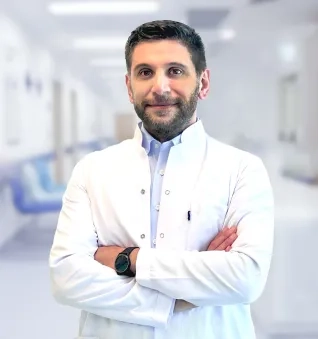Alo Yeditepe
Alo Yeditepe
Causes of Male Factor Infertility
Infertility is classified as female factor, male factor, both male and female factor or idiopathic cases. Female factor is accompanied by male factor in around 35% of infertile couples, while male factor is the only identified cause in approximately 10% of cases.
Oligozoospermia – count of sperm in ejaculate lower than the accepted normal range - or azospermia – total absence of sperm in ejaculate – is detected in a certain percentage of men with infertility, while sperm count is within normal ranges in others with infertility. Sperm concentration is low along with poor sperm quality, low motility (astenozoospermia) and/or count of sperms with abnormal morphology are more than healthy sperms in 80 percent of infertile men. In a low percentage of infertile men; there are normal sperm concentrations, with low quality sperms having normal sperm count, morphology and motility, although these cases are rare.
Congenital Problems, Chronic Diseases Can Also Cause!
Male infertility can be caused by insufficient production of sperm in testes, poor functioning of sperms and blockage in tubes that pass sperm in the body. Other potential causes of infertility are chronic diseases, endocrine disorders, genetic problems, congenital anomalies, past history of infection, trauma, varicocele (dilated veins around testicles) and surgical operations.
Infertile men may not have a complaint other than failure of pregnancy in partner. However, others may suffer from signs that point to chromosomal or hormonal problems, such as sexual dysfunctions (e.g. problems in erection or ejaculation, low sex drive), testicular swelling, redness and pain as well as recurrent respiratory tract infections, anosmia (inability to sense one or all smells), abnormal enlargement of breast (gynecomastia) and loss of scalp or body hair. Evaluation requires review of detailed medical history, physical examination and semen analysis. They can be supplemented by hormone tests, imaging of accessory gland and channels and genetic tests, whenever required.
How Is Sperm Analysis Done?
Sperm analysis is a relatively simple test to evaluate etiology of male infertility and it requires sexual abstinence for 2 to 7 days. Generally, patient is asked to ejaculate into a sterile container through masturbation in a private room. However, the sample should be obtained at home and transferred to the clinic within 30 minutes, if the former approach is not feasible. It is recommended to do semen analysis at least twice due to inter-sample variability.
Semen specimen is evaluated according to the criteria set by World Health Organization (World Health Organization Laboratory Manual for the Examination and Processing of Human Semen).
Causes of Male Factor Infertility
Severe Oligospermia and Azospermia
The condition implies very low count or absence of sperm in ejaculate (fluid ejected from the male reproductive tract in orgasm – semen). The condition may be caused by failure to produce sperm in testicle, poor development of sperm channels or their blockage, genetic diseases (Y chromosome problems, Klinefelter syndrome), infection, trauma, chemotherapy, radiotherapy or cystic fibrosis. Patients with azospermia or severe oligospermia require certain hormone tests (FSH, LH, and testosterone), genetic analyses and imaging of ejaculatory channels.
Varicocele
It refers to swelling and varicose formations in blood vessels that drain testicles. Varicocele is the most common correctable cause of male infertility. Although the exact cause is not known, it is believed that the condition correlates with heat dysregulation at testicular locus. Diagnosis requires physical examination by an urologist and scrotal Doppler ultrasound. Surgical intervention may improve count and function of sperm.
Treatment of Male Factor Infertility
Considering treatment of male infertility, the underlying cause should be, first, corrected. Lifestyle changes, reduction of stress factors, regular eating, weight loss and cessation of smoking and alcohol consumption are recommended. Medication treatment is principally reserved for hormone deficiencies.
Insemination can be recommended, if sperm count is above 10 million in semen and there is no severe morphological abnormality. In this method, sperm is cleaned off dead cells and toxic substances and inserted into uterine cavity through cervix with a catheter. Chance of pregnancy is 10 to 15 percent in this method. In vitro fertilization (IVF) is considered, if insemination is not indicated or fails. Intracytoplasmic sperm injection (ICSI) differs from IVF, as sperms are injected into the egg under microscope rather than a natural fertilization.
Sperms are harvested from testicles with surgical approach in patients with non-obstructive azospermia who have no sperm in semen. The procedure that is carried out under anesthesia is called TESE. It is not possible to produce sperm, if analysis of Y chromosome points to total deletion of Azf A locus, total deletion of Azf B locus or deletion of Azf A, B and C loci. Therefore, these patients are not candidates forTESE. In case of obstructive azospermia, sperm can be aspirated with TESA method.
As is the case with oocyte cryopreservation, sperm freezing allows storage of sperms for future use. Viability of sperms can be maintained for many years, if they are frozen correctly. Sperm cryopreservation is considered for patients before cancer treatment, before surgery or in case of failure to give semen specimen while on treatment of infertility or those with low sperm count.
This content was prepared by Yeditepe University Hospitals Medical Editorial Board.
”
See Also
- What is Whooping Cough? The Importance of Whooping Cough Vaccination During Pregnancy
- Contraceptive Methods: Birth Control and Effective Protection Options
- What is Ovarian Reserve?
- Uterine Polyps, Symptoms and Treatment
- Genetic Diagnosis in IVF Treatment
- What Happens at 3rd Weeks of Pregnancy?
- What Happens at 2nd Week of Pregnancy?
- What is Endometriosis? What are the Symptoms of Endometriosis?
- What is Hormone Replacement Therapy (HRT)? How is HRT Performed?
- Hormonal Disorder Symptoms and Treatment
- What is Ureaplasma? How is Ureaplasma Treatment Done?
- What is Pelvic Floor? What are Their Duties?
- The Most Common Diseases in Women
- What is Hysteroscopy? Hysteroscopy Usage Areas
- What is Myoma? Myoma Symptoms and Treatment
- Early Menopause and Ovarian Failure Can Be Prevented
- What is Laparoscopic Surgery in Gynecology?
- Menopause Symptoms and Menopause Treatment
- Polycystic Ovary Syndrome and its Treatment
- Electromagnetic Stimulation in the Treatment of Endometriosis and Infertility
- How Does Working Life Affect Prospective Mothers?
- Causes of Female Infertility
- The Use of Non-Inpatient Closed Surgery is Increasing in Gynecological Diseases
- Chronic Pelvic Pain
- What is Polycystic Ovary Syndrome/PCOS?
- Postpartum Period
- 7 Effective Tips Against Urinary Incontinence
- What is Menopause? When Does Menopause Age Begin? What are the Symptoms of Menopause?
- The Chance of Becoming a Father Increases with Microchip Technology
- Thanks to the Ovarian Rejuvenation Method, She Counts the Days for Birth!
- Tests That Need to Be Performed During Pregnancy
- Which Tests Should Expectant Mothers Not Neglect? What Tests Should Be Done While Pregnant?
- Some Patients Go Through Menopause Even at the Age of 15
- Stress Disrupts the Menstrual Cycle
- Myomas Can Grow During Pregnancy
- Useful Bacteria Increases IVF Success
- Polycystic Ovary Syndrome Can Occur If the Bacteria in the Gut Are Not Functioning Well
- Imaging Methods During Pregnancy
- After 16 Years, She Wanted to Be a Mother Again; She Experienced the Shock of Her Life
- These Diseases Affect Women Differently Than Men
- Beware of Chocolate Cyst! It Affects 1 in 10 Women
- The Effect of Advanced Age on IVF Treatment
- Infertility
- Polycystic Ovary Syndrome
- Early Menopause
- Blocked Fallopian Tube
- Vaginismus
- Low Ovarian Reserve (AMH)
- Which Methods Increase Success in Treatment of Infertility?
- Intrauterine insemination (IUI)
- Microinjection
- Egg Cryopreservation
- Assisted Hatching
- Micro-chip
- Pre-implantation Genetic Diagnosis
- Thyroid Diseases During Pregnancy Affect the Baby as Much as the Mother
- Urinary Tract Infections Can Be A Sign Of Menopause
- 10 Overlooked Signs of Menopause
- Endometriosis
- Co-Culture
- Ovarian Rejuvenation / PRP
- As Average Life Expectancy Increases, This Problem Will Be Seen More
- 'Early Age' Warning for Egg Freezing Procedure
- Beware, These Risks Increase After Menopause!
- This Problem Ruins the Lives of One in Every 10 Women
- Getting Cancer Treatment Does Not Stop You from Having Children!
- Prof. Dr. Attar: Endometriosis Can Be Associated With Some Chronic Diseases
- What Is the Period of Fertility? What Tests are Performed for Fertility?
- What Happens at 38 Weeks of Pregnancy?
- What Happens at 37 Weeks of Pregnancy?
- What Happens at 36 Weeks of Pregnancy?
- What Happens at 35 Weeks of Pregnancy?
- What Happens at 34 Weeks of Pregnancy?
- What Happens at 33 Weeks of Pregnancy?
- What Happens at 32 Weeks of Pregnancy?
- What Happens at 31 Weeks of Pregnancy?
- What Happens at 30 Weeks of Pregnancy?
- What Happens at 29 Weeks of Pregnancy?
- What Happens at 28 Weeks of Pregnancy?
- What Happens at 27 Weeks of Pregnancy?
- What Happens at 26 Weeks of Pregnancy?
- What Happens at 25 Weeks of Pregnancy?
- What Happens at 24 Weeks of Pregnancy?
- What Happens at 23 Weeks of Pregnancy?
- What Happens at 22 Weeks of Pregnancy?
- What Happens at 21 Weeks of Pregnancy?
- What Happens at 20 Weeks of Pregnancy?
- What Happens at 19 Weeks of Pregnancy?
- What Happens at 18 Weeks of Pregnancy?
- What Happens at 17 Weeks of Pregnancy?
- What Happens at 16 Weeks of Pregnancy?
- What Happens at 15 Weeks of Pregnancy?
- What Happens at 14 Weeks of Pregnancy?
- What Happens at 13 Weeks of Pregnancy?
- What Happens at 12 Weeks of Pregnancy?
- What Happens at 11 Weeks of Pregnancy?
- What Happens at 10 Weeks of Pregnancy?
- What Happens at 9 Weeks of Pregnancy?
- What Happens at 8 Weeks of Pregnancy?
- What Happens at 7 Weeks of Pregnancy?
- What Happens at 6 Weeks of Pregnancy?
- What Happens at 5 Weeks of Pregnancy?
- What Happens at 4 Weeks of Pregnancy?
- What Happens at 1st. Weeks of Pregnancy?
- Considerations for Embryo Transfer
- What Causes Menstrual Irregularity, How Is It Treated?
- Success in IVF after 43 Decreases to Five Percent
- Does Pregnant Coronaviruses Affect?
- Most Frequently Asked Questions During Pregnancy
- Untreated Genital Problems Can Cause Urinary Incontinence
- 1 in 10 Women Have This Problem; It Can Lead To Infertility
- Effective Results Can Be Achieved with PRP in Women with Low Egg Count
Alo Yeditepe









